UPSC GS 2
Quad
- News: Prime Minister Narendra Modi arrived in the United States, where he participated in the sixth Quad Leaders’ Summit in Wilmington, Delaware.
- What is Quad? The Quadrilateral Security Dialogue (Quad) is a grouping of four democracies:
-
- India
- Australia
- United States
- Japan
-
- Aim: The primary aim of Quad is to ensure a free and open international order based on the rule of law in the Indo-Pacific region.

- Objectives: The key objectives of the Quad include:
-
- Ensuring maritime security.
- Combating the Covid-19 crisis, particularly through vaccine diplomacy.
- Addressing climate change risks.
- Creating an investment ecosystem in the region.
- Boosting technological innovation.
-
Read also: Bombay High Court Strikes Down Centre’s Amended IT Rules | UPSC
- Evolution of Quad:
-
- It was first formally proposed by Japanese Prime Minister Shinzo Abe in 2007.
- In 2017, during the ASEAN Summits, the four nations rejoined negotiations to revive the Quad.
- The first-ever Quad leaders’ summit was held virtually in March 2021 and was hosted by the US.
- The first in-person summit was hosted by the US in September 2021.
- In November 2020, the navies of all four Quad members participated in the Malabar exercise, their largest joint naval drill.
-
- Key Outcomes of Quad Summit 2024:
-
- Quad Wilmington Declaration: The Quad adopted the Quad Wilmington Declaration to advance their agenda.
- Quad Cancer Moonshot: A new initiative, the Quad Cancer Moonshot, was launched to reduce the burden of cancer in the Indo-Pacific region. It focuses on:
- Leveraging collective investments and scientific expertise.
- Contributions from the private and non-profit sectors.
- Initially targeting cervical cancer.
- Laying the groundwork to address other forms of cancer in the future.
- Maritime Initiative for Training in Indo-Pacific (MAITRI): The MAITRI initiative was announced to help regional partners utilize tools from the Indo-Pacific Maritime Domain Awareness (IPMDA) and other Quad initiatives. The initiative focuses on:
- Improving maritime awareness and response capabilities in the Indo-Pacific.
- Enhancing monitoring, security, and law enforcement.
- Deterring illegal activities in regional waters.
- India will host the inaugural MAITRI workshop in 2025.
- A maritime legal dialogue will support a rules-based maritime order, with enhanced IPMDA capabilities introduced over the next year.
- Quad-at-Sea Ship Observer Mission 2025: Plans for the first-ever Quad-at-Sea Ship Observer Mission were announced, involving the US, Japan, Australia, and Indian Coast Guards.
- Quad Indo-Pacific Logistics Network: The leaders launched the Quad Indo-Pacific Logistics Network pilot project to share airlift capacity and leverage logistics strengths.
- Quad Ports of the Future Partnership: The Quad Ports of the Future Partnership was introduced to support sustainable and resilient port infrastructure development across the Indo-Pacific region.
- Semiconductor Supply Chains Contingency Network Memorandum of Cooperation: The Semiconductor Supply Chains Contingency Network aims to enhance the resilience of Quad’s semiconductor supply chains.
- Other Announcements:
- A collective Quad effort to boost energy efficiency, focusing on high-efficiency affordable cooling systems in the Indo-Pacific region.
- India’s space-based web portal for Mauritius, supporting space-based monitoring of extreme weather events and climate impacts.
- A new Quad STEM Fellowship sub-category, announced by India, for students in the Indo-Pacific to pursue a 4-year bachelor’s level engineering program at a Government of India-funded technical institute.
-
- Future Quad Summits: The Quad Leaders’ Summit 2025 will be hosted by India.
Advocate-on-Record (AoR)
- News: The Supreme Court recently stated that advocates-on-record (AoR) in a case must mark the appearance of only those lawyers who are authorized to appear and argue the case on a particular day.
- Advocate-on-Record (AoR):
-
- An AoR is a legal professional entitled to represent clients and plead for them in the SC.
- The concept of AoR was introduced by the SC under the power granted by Article 145(1) of the Indian Constitution, which allows the SC to make rules for regulating practices and procedures in the court.
- AoRs belong to a specific category of advocates with exclusive rights of audience in the SC.
- AoRs have the exclusive right to file and conduct cases in the SC.
- All procedural aspects are handled by the AoR with the assistance of a registered clerk. This includes:
- Drafting and filing petitions, applications, and other legal documents.
- Any notice, order, or correspondence by the SC is sent to the AoR.
- AoRs specialize in the practices and procedures of the SC, familiar with its rules and regulations, and play a key role in navigating legal matters through the highest court in the country.
- No other High Court in India has a similar provision for AoRs.
-
- Requirements to Become an AoR (as per Order IV Rule 5 of Supreme Court Rules, 2013):
-
- The advocate must be enrolled with a State Bar Council.
- The advocate should have at least 4 years of experience.
- The advocate must undergo 1 year of training under a senior AoR.
- The advocate must pass the examination conducted by the SC.
- The advocate must have an office in Delhi, within a radius of 10 miles from the SC, and provide an undertaking to employ a registered clerk within one month of registration as an AoR.
-
- AoR Unique Identification:
-
- Once registered, an AoR is issued a unique identification number, which must be used on all documents filed in the SC.
-
International Big Cat Alliance
- News: India has formally joined the International Big Cat Alliance (IBCA), which it launched in 2023.
- International Big Cat Alliance (IBCA):
- Launch Date: The IBCA was launched on April 9, 2023, during the commemoration of 50 years of India’s Project Tiger.
- Aim
-
- International Big Cat Alliance aims at securing the future of cats — tiger, lion, leopard, snow leopard, puma, jaguar and the cheetah.
- Out of these, five are found in India: Tiger, Lion, Leopard, Snow Leopard, and Cheetah.
-
- Membership:
-
- Currently, four countries—India, Nicaragua, Eswatini, and Somalia—are members of the IBCA.
- Additionally, nine international organizations have partnered with the Alliance.
-
- Headquarters: The Union Cabinet approved the establishment of the IBCA Headquarters in India.
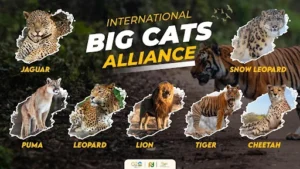
- Objectives and Scope of IBCA:
-
- Global Multi-Country Coalition: IBCA is envisioned as a multi-country, multi-agency coalition involving 95 big cat range and non-range countries, along with conservation partners, scientific organizations, and businesses.
- Centralized Conservation Platform: The IBCA aims to establish a common platform for sharing successful conservation practices, technical know-how, and financial resources to arrest the decline in big cat populations.
- Gold Standard Conservation Practices: The Alliance focuses on disseminating gold-standard practices for big cat conservation and providing access to a central repository of knowledge.
- Collaboration and Synergy: Through its collaborative platform, the IBCA will strengthen species-specific intergovernmental initiatives and transnational efforts on big cat protection.
- Addressing Climate Challenges: The Alliance will also work to mitigate challenges from climate change by safeguarding big cat habitats, contributing to climate adaptation, water and food security, and the well-being of communities dependent on these ecosystems.
-
UPSC GS 3
Global Cybersecurity Index
- News: India has achieved Tier 1 status in Global Cybersecurity Index 2024.
- Definition:
-
- The Global Cybersecurity Index (GCI) is a trusted reference that measures the commitment of countries to cybersecurity on a global level.
- The GCI is published by the International Telecommunication Union (ITU).
-
- Aim:
-
- The aim is to raise awareness of the importance and different dimensions of cybersecurity.
-
- Process:
-
- Each country’s level of development and engagement is assessed across five key pillars:
- Legal Measures
- Technical Measures
- Organizational Measures
- Capacity Development
- Cooperation
- The scores from these pillars are aggregated into an overall score for each country.
-
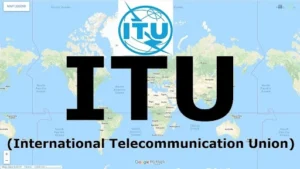
- Key Highlights of GCI 2024:
-
- 46 countries have been placed in Tier 1, which is the highest of the five tiers, designated for “role-modelling” countries that demonstrate strong commitments in all five cybersecurity pillars.
- India has achieved a remarkable score of 98.49 out of 100, placing it among the top ‘role-modelling’ countries, showcasing a strong global commitment to cybersecurity practices.
- Southeast Asia countries Singapore, Indonesia, Malaysia, Thailand, and Vietnam make it to the Tier 1 in this GCI 2024.
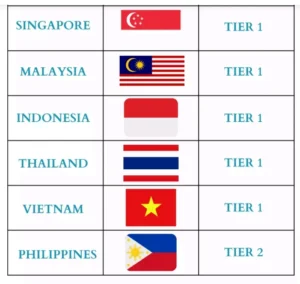
- Most other countries are either:
- “Establishing” (Tier 3)
- “Evolving” (Tier 4) in terms of cybersecurity development.
-
- International Telecommunication Union
-
- Established: 1865 as the International Telegraph Union.
- Specialized Agency: Became a specialized agency of the United Nations in 1947.
- Role: An intergovernmental organization coordinating between governments and private sector bodies for global telecommunication and information communication technology (ICT) services.
- Member Countries: 193 countries. India has been a regular member of the ITU Council since 1952.
-
- Key Functions:
-
- Allocating global radio spectrum and satellite orbits.
- Coordinating and setting technical standards for telecommunication/ICT.
- Improving access to ICTs in underserved communities globally.
- Headquarters: Geneva, Switzerland.
-
Amur Falcon (Falco Amurensis)
- News: Authorities in Tamenglong district (Manipur) are implementing measures to protect Amur falcons during their roosting period.
- Amur Falcon:
-
- Amur falcon is a small migratory raptor, famous for making the longest voyage from its breeding grounds in Russia and China to spend the winter in South Africa.
- Amur falcons are the world’s longest migratory birds who can travel over 22,000 kilometers without taking many breaks in between.
- Often, Amur falcons make a stop in eastern India.
- They are locally known as Akhuipuina, especially in the states of Manipur and Nagaland.
-
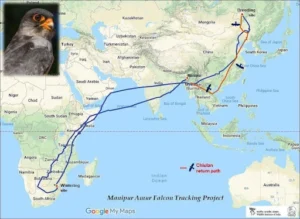
- Conservation Efforts:
-
- Protected under the Wildlife Protection Act 1972, and included under Schedule IV.
- Hunting or possessing the bird’s meat is punishable by up to three years imprisonment or a fine of up to ₹25,000, or both.
- In 2018, the forest department initiated a conservation programme by radio-tagging the birds to study their migratory routes.
-
- IUCN Status: Classified as Least Concern by the IUCN.
Europa Clipper Mission
- News: NASA is set to launch the Europa Clipper mission on October 10, 2024, aiming to explore Jupiter’s icy moon Europa.
- Europa Clipper Mission:
-
- Europa Clipper is a NASA mission designed to study Jupiter’s icy moon Europa.
- The mission will place a spacecraft in orbit around Jupiter to carry out a detailed investigation of Europa.
-
- Objectives:
-
- The mission aims to determine whether Europa, an ice-encased moon, could be habitable.
- Europa shows strong evidence of an ocean of liquid water beneath its icy crust.
-
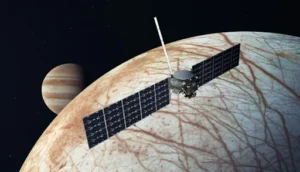
- Spacecraft Specifications:
-
- The spacecraft extends 100 feet (30.5 meters) in length and about 58 feet (17.6 meters) across.
- It is the largest spacecraft NASA has ever developed for a planetary mission.
-
- Mission Operations:
-
- Europa Clipper will orbit Jupiter and perform 49 close flybys of Europa to gather data.
- The goal is to determine if there are habitable environments beneath the moon’s thick frozen crust.
- The spacecraft carries nine science instruments and a gravity experiment using its telecommunications system.
-
- Data Collection:
-
- All instruments will operate simultaneously during each flyby to obtain comprehensive data.
- Scientists will layer the data from each instrument to create a full picture of Europa’s potential to support life.
-
- Power Source: The spacecraft uses large solar arrays to collect enough light for its power needs while operating in the distant Jupiter system.
Lac Farming
- News: President Droupadi Murmu recently batted for lac farming while taking part in the centenary celebration of the ICAR-National Institute of Secondary Agriculture (NISA) in Ranchi.
- Definition of Lac Farming:
-
- Lac farming involves the cultivation of lac insects, primarily Kerria lacca, on host trees.
- These insects secrete a resin, which is harvested to produce lac, a natural resin used in various industries.
-
- Importance for Tribal Communities:
-
- Tribal communities in India predominantly produce lac, which serves as a significant source of income.
- It is a key livelihood activity in states like Jharkhand, Chhattisgarh, Odisha, and West Bengal.
-

- Applications of Lac:
-
- Lac is used in industries such as pharmaceuticals, cosmetics, food processing, and in making varnishes and polishes.
- Its non-toxic and biodegradable properties make it valuable across diverse sectors.
-
- Economic Potential:
-
- Lac farming offers immense economic potential, with many farmers earning substantial profits from it.
- There is rising demand in domestic and international markets, particularly in the pharmaceutical and cosmetic industries.
-
- Role of Secondary Agriculture:
-
- Lac farming falls under secondary agriculture, involving value addition to primary agricultural products.
- It promotes sustainable resource use and increases farmer income by utilizing agricultural waste.
-
- Government Support and Training:
-
- The government offers training programs through institutions like ICAR-NISA to help farmers improve their lac farming techniques.
- The plan to train 5,000 farmers annually aims to boost both yields and income.
-
- Environmental Impact:
-
- Lac farming has a low environmental impact and supports sustainable agricultural practices by utilizing forest resources without contributing to deforestation.
-
Valmiki Tiger Reserve
- News: A leopard was found dead in the Valmiki Tiger Reserve (VTR) in the West Champaran district of Bihar.
- Location: VTR is situated at the India-Nepal border in the northern part of the West Champaran district of Bihar.
- Area: It spreads over an area of approximately 880 sq. km, making it the only tiger reserve in Bihar.
- Composition: Comprises the Valmiki National Park and the Valmiki Wildlife Sanctuary.
- Geographical Significance:
-
- Forms the easternmost limit of the Himalayan Terai forests in India.
- Located in the Gangetic Plains bio-geographic zone, featuring a mix of Bhabar and Terai tracts.
-
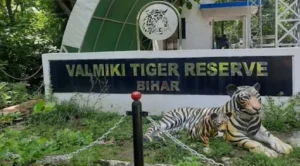
- Surroundings: Bordered by the Royal Chitwan National Park of Nepal to the north and the Gandak River to the west, with the Himalayan mountains in the background.
- Drainage: Rivers Gandak, Pandai, Manor, Harha, Masan, and Bhapsa flow through the reserve.
- Vegetation: Riparian fringes, Alluvial grasslands, high-hill savannah, and Wetlands, Moist mixed deciduous, Open-land vegetation, Sub-mountainous semi-evergreen formation, Freshwater swamps.
- Fauna: Tiger, leopard, fishing cat, leopard cat, sambar, hog deer, spotted deer, black buck, gaur, sloth bear, langur, rhesus monkey, etc.
- Flora: Sal, rohini, sihor, teak, bamboo, semal, Mandar, shisham, Jamun, Gular, etc.
Read also: Indus Water Treaty: Key Agreement Between India & Pakistan | UPSC
Exercise AIKYA
- News: The National Disaster Management Authority (NDMA), in collaboration with the Southern Command of the Indian Army organised a two-day national symposium, ‘Exercise AIKYA’, on disaster management in Chennai.
- Exercise AIKYA:
-
- Meaning: “Aikya” translates to “Oneness” in Tamil, symbolizing the exercise’s goal to integrate India’s disaster management community.
- Objective: To enhance disaster preparedness and response capabilities by bringing together key stakeholders from across Peninsular India.
-
- Participation: The exercise involved stakeholders from six southern states and Union Territories:
-
- Tamil Nadu
- Kerala
- Karnataka
- Andhra Pradesh
- Telangana
- Puducherry
-
- Key Organizations Involved: The following organizations played significant roles in the exercise:
-
- India Meteorological Department (IMD)
- National Remote Sensing Centre (NRSC)
- Indian National Centre for Ocean Information Services (INCOIS)
- Central Water Commission (CWC)
- Forest Survey of India (FSI)
- Geographical Survey of India (GSI)
- Department of Telecommunications (DoT)
-
- Exercise Activities:
-
- Simulation: Conducted emergency simulations to test roles and responsibilities among various stakeholders.
- Discussions: Fostered discussions on emerging technologies and trends in disaster relief.
- Review: Evaluated lessons learned from recent disaster operations.
-
- Focus Areas:
-
- The discussions at AIKYA covered a range of pressing issues, including tsunamis, landslides, floods, forest fires, cyclones, and recent disasters that have impacted India and the world.
-

